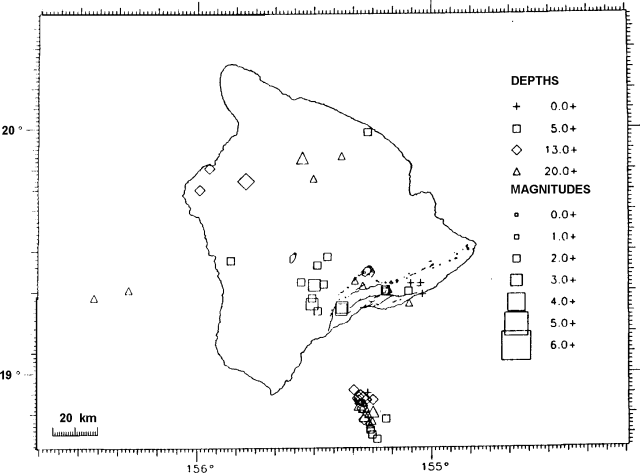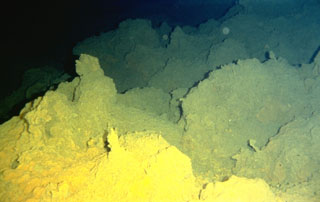Report on Kama'ehuakanaloa (United States) — January 1989
Scientific Event Alert Network Bulletin, vol. 14, no. 1 (January 1989)
Managing Editor: Lindsay McClelland.
Kama'ehuakanaloa (United States) Earthquake swarm may document magma intrusion
Please cite this report as:
Global Volcanism Program, 1989. Report on Kama'ehuakanaloa (United States) (McClelland, L., ed.). Scientific Event Alert Network Bulletin, 14:1. Smithsonian Institution. https://doi.org/10.5479/si.GVP.SEAN198901-332000
Kama'ehuakanaloa
United States
18.92°N, 155.27°W; summit elev. -975 m
All times are local (unless otherwise noted)
An earthquake swarm, detected 24 January 1989 from 0736 to 1009, included 12 relatively large events (M 2.5-3.6) and 15 smaller events (M 1.3-2.5) superimposed on continuous background tremor (figure 3). Ten events (M 1.5-2.3) of relatively high frequencies followed during the remainder of the day, then declined. After four events [of M 1.3-2.5] on the 25th, only sporadic seismicity [consisting of four more events during 26-31 January of M 1.2-2.9] was recorded. Frequencies were characteristic of tectonic-type events, suggesting to USGS geophysicists that they may have marked an intrusive episode, but probably not an eruption. Depth control was limited, since the nearest seismic station is on the S coast of Hawaii, >30 km away.
 |
Figure 3. Preliminary locations of January 1989 earthquakes (M > 2.0) at Lōʻihi and on the island of Hawaii. Courtesy of Robert Koyanagi, USGS Hawaiian Volcano Observatory. |
Geological Summary. The Kama’ehuakanaloa seamount, previously known as Loihi, lies about 35 km off the SE coast of the island of Hawaii. This youngest volcano of the Hawaiian chain has an elongated morphology dominated by two curving rift zones extending north and south of the summit. The summit region contains a caldera about 3 x 4 km and exhibits numerous lava cones, the highest of which is about 975 m below the ocean surface. The summit platform also includes two well-defined pit craters, sediment-free glassy lava, and low-temperature hydrothermal venting. An arcuate chain of small cones on the western edge of the summit extends north and south of the pit craters and merges into the crests prominent rift zones. Seismicity indicates a magmatic system distinct from that of Kilauea. During 1996 a new pit crater formed at the summit, and lava flows were erupted. Continued volcanism is expected to eventually build a new island; time estimates for the summit to reach the ocean surface range from roughly 10,000 to 100,000 years.
Information Contacts: R. Koyanagi, USGS Hawaiian Volcano Observatory.

